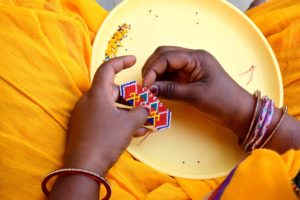Reviving The Golden Legacy Of Usta Craft
Introduction
The greatness of an art form lies in how well it connects with the viewer as well as with various elements of itself. There is a reason Indian artifacts and handcrafts are revered around the world.
The arts and crafts of India exhibit the spirit of tolerance and diversity that has made us who we are. The beautiful blend of epochs and cultures has created some of the best examples of artistic brilliance we see across the nation.
At Swarang we don’t just take pride in the richness of our traditional art forms. We see their value and contribution in bringing people, communities, and ideas together. We are not just working to save the craft. We are building livelihoods and products that save our sense of identity as the people of this land. That’s why we take pride in what we create, hoping that you feel proud in carrying this exquisite piece of art.
In this blog post, we are going to talk about one such art form that stands as a testimony to the Indian spirit of unity in diversity as well as the pursuit of art for the sake of creativity.
Usta Craft. Historical Significance
Usta, originating from the Persian word ‘Ustad’ means master. This unique art form of painting on camel hides originated from Iran and found a distinct place in the Indian art scene during the Mughal rule. Under the patronage of Raja Rai Singh of Bikaner, Usta artisans developed new streams of Usta art. The extraordinary manifestation of these new designs and forms is stillthriving and can be seen in Bikaner’s fabulous Junagarh Fort’s Anoop palace, Chandra palace, Karan palace and Phool Mahal.
Traditionally known as the Sunehri Munawwati Nakkashi work (gold emboss work) it was done on walls, ceilings, glass, wood, marbles and artifacts made of camel leather. The most commonly used motifs were foliage, animals and birds. During the British Rule, the art form was made functional and hence performed on lighter objects like clothes, leather, utensils etc to make it portable and easy to sell.
The descendants of the ustads (masters) are still practicing this art and it continues to evolve in the light of contemporary fashion and designs.
The Process
Usta is completed in many stages. To begin with, we prepare a smooth surface with the use of a natural primer. After measuring for designs, the drawings are drawn on this surface. This completes the first stage.
The designs are then filled with a squirrel hair brush and colour. Next, the embossing is done using a paste prepared with pot clay powder, gum, jaggery and naushadar. After applying a coat of yellow paint on the emboss, the gold foils are put on it. The fine and intricate details of the design are then drawn through a brush and blended with the rest of the paint.
Our Inspiration: Blend of tradition and the modern chic style
Our inspiration for our handcrafted leather bags collection lies in the interior carvings and arches at the Junagarh Fort. The immaculate lines, intricate motifs are in perfect harmony with each other and the overall aesthetics of the place. It was almost impossible not to reimagine their beauty on leather.
Usta On Leather – A Match Made In Heaven
After many rounds of conceptualization, ideation and design for the drafts, we have come up with an exquisite collection of usta-inspired leather products. The range of products is just what you need to stay connected with the beautiful history and legacy of our traditions.
Traditional ethnic designs mixed with contemporary silhouettes make this collection perfect for festive appearances as well as occasions when you need to stand apart and feel special. The beautiful, rich tones of cherries, browns, greens and blues compliment the craft as well as appeal to multiple color sensibilities.
Build your own versatile wardrobe or gift it to your fashion connoisseur friends.
Wrap an usta craft belt around your flowing saree or team up our versatile handbags with western or traditional wear. In any case, it is bound to make that first impression last forever. What’s more.
Every time you buy a local indigenous product it gives hope and a chance at livelihood to hundreds of our artisans who have kept the legacy of this beautiful art form alive. That’s enough reason to smile now, isn’t it?
Carry with style and wear with pride. This is not just a product, it’s your connection to history.

